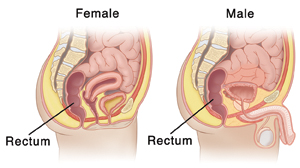An object in the body that is not supposed to be there is called a foreign body. Objects that are easy to put into the rectum can be very hard to get out again. Trying to remove them can lead to swelling and spasms of the rectal muscles. It can also lead to both internal and external cuts and bruising. This can make getting the object out even harder.
An object stuck in the rectum can be very painful. It can cause bleeding. It may also puncture the wall of the rectum. This can be very serious and might need surgery to repair. If the object is in the rectum for a time, infection can develop.
X-rays or other tests may be done to get a view of the object and where it is. The goal is to remove the object from the rectum without causing further damage. This can often be done safely in the emergency room. Medicine may be given to relax you and prevent pain during removal. If the object can't be removed in the emergency room, you may need to have it removed under anesthesia in the operating room. After the object is removed, the rectum is checked for signs of injury or infection.
Home care
Medicine may be prescribed to help ease pain and swelling. Take all medicine as directed. If your health care provider prescribed antibiotics, take them as directed. Do not stop taking them just because you feel better. You need to take the full course of antibiotics.
The following are general care guidelines:
-
If you were given relaxing medicine for the removal, don't drive or operate heavy equipment for 24 hours.
-
Don't put anything into your rectum for at least a week. This allows it to heal.
-
Drink plenty of water and increase the amount of fiber in your diet to prevent constipation. You can do this by eating fruits, vegetables, and whole-grain breads.
-
If passing stool is painful, use a stool softener for a few days. Take these by mouth, instead of using a suppository.
-
Try not to strain to have a bowel movement. The strain may cause more damage.
-
If using vibrators or dildos for sex play, choose one made for insertion into the rectum. These have safety features that keep them from getting stuck.
-
If there are any tears or cuts in the anal area, care for them as directed. Keep the area clean and dry, especially after having a bowel movement. You can do this by gently rinsing the anus with warm water and patting dry.
Follow-up care
Follow up with your provider as advised. If you have damage to the rectum, you may be referred to a specialist.
Call 911
Call
-
You have heavy bleeding.
-
Your belly (abdomen) is swollen, tense, or very painful.
-
You faint or lose consciousness.
-
You have trouble breathing.
-
You have a rapid heart rate.
When to contact your doctor
Contact your provider right away if:
-
You have a fever of 100.4°F (38°C) or higher, or as advised by your provider.
-
You have chills.
-
You have bleeding or discharge from the rectum.
-
You have rectal pain that gets worse, especially when you try to have a bowel movement.
-
You can't hold your bowel movement until you get to a bathroom.
-
You have nausea or vomiting.


